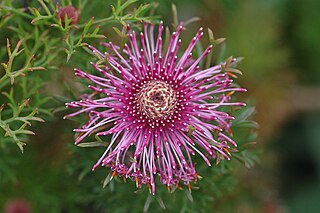
Isopogon formosus, commonly known as rose coneflower, is a species of flowering plant in the family Proteaceae and is endemic to the south-west of Western Australia. It is a shrub with divided leaves with cylindrical segments, and spherical to oval heads of pink or red flowers.
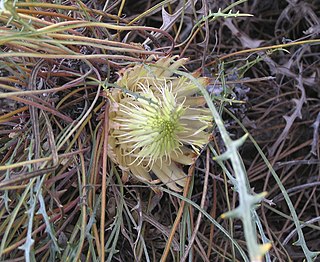
Banksia rufa is a species of prostrate shrub that is endemic to the south-west of Western Australia. It has broadly linear, pinnatifid or pinnatipartite leaves with between five and twenty lobes on each side, yellow, orange or brownish flowers in heads of forty or more, and glabrous, egg-shaped follicles.

Banksia hirta is a species of shrub that is endemic to Western Australia. It has hairy stems, deeply serrated leaves, pale yellow flowers in heads of about one hundred and shining follicles. It is restricted to the Stirling Range National Park.

Banksia prolata is a species of bushy shrub that is endemic to Western Australia. It has linear, serrated or pinnatifid leaves, yellow flowers in heads of between 150 and 250, and egg-shaped follicles.

Banksia serratuloides is a species of small shrub that is endemic to Western Australia. It has linear, pinnatipartite leaves, yellow and pink flowers in heads of about forty and hairy, wrinkled follicles.
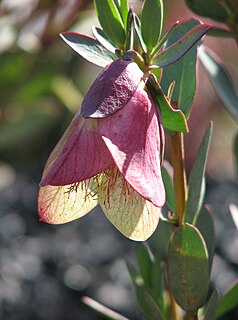
Pimelea physodes, commonly known as Qualup bell, is a species of shrub that is endemic to Western Australia. It has egg-shaped to narrow elliptical leaves and distinctive bell-like inflorescences with tiny greenish flowers surrounded by long elliptical bracts. The inflorescence resembles those of some of the only distantly-related darwinia "bells" and the bracts are a combination of red, purple, green and cream-coloured.

Isopogon sphaerocephalus, commonly known as drumstick isopogon or Lesueur isopogon, is a species of plant in the family Proteaceae and is endemic to the south-west of Western Australia. It is a shrub with linear to narrow egg-shaped leaves and spherical heads of hairy white to creamy yellow flowers.
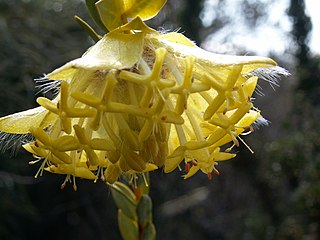
Pimelea suaveolens, commonly known as scented banjine, is a slender shrub with large, rather hairy yellow inflorescences. It occurs in forest areas of the south-west of Western Australia from New Norcia to Albany.
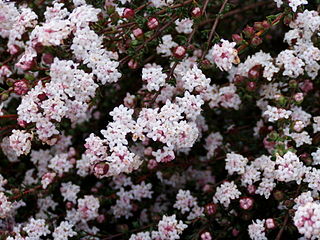
Pimelea brachyphylla is a species of flowering plant in the family Thymelaeaceae and is endemic to the south-west of Western Australia. It is an erect to spreading shrub with linear to elliptic leaves and clusters of white, tube-shaped flowers.

Grevillea bracteosa, also known as bracted grevillea, is a species of flowering plant in the family Proteaceae and is endemic to the south-west of Western Australia. It is an erect to spreading shrub usually with linear leaves, and oval to more or less spherical clusters of glabrous pale green to greenish-pink flowers with a pink or white style.

Petrophile conifera is a species of flowering plant in the family Proteaceae and is endemic to southwestern Western Australia. It is a bushy, much-branched shrub with pinnate, sharply-pointed leaves, and oval heads of hairy, cream-coloured to yellowish white flowers.
Petrophile filifolia is a species of flowering plant in the family Proteaceae and is endemic to southwestern Western Australia. It is a small shrub with curved, long, needle-shaped leaves and more or less spherical heads of hairy cream-coloured to pale yellow flowers.
Petrophile pilostyla is a species of flowering plant in the family Proteaceae and is endemic to southwestern Western Australia. It is a shrub with needle-shaped, sharply-pointed leaves and spherical heads of hairy, cream-coloured or pale yellow flowers.
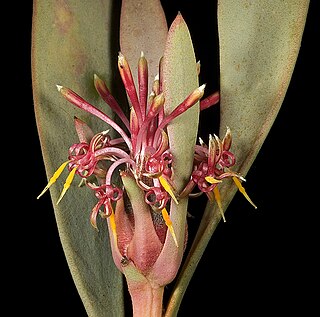
Isopogon pruinosus is a species of flowering plant in the family Proteaceae and is endemic to southwestern Western Australia. It is a compact, spreading shrub with narrow egg-shaped leaves with the narrower end towards the base and spherical to elliptic heads of pink flowers.
Pimelea pagophila, commonly known as the Grampians rice-flower, is a species of shrub in the family Thymelaeaceae. It has a restricted distribution, white flowers in spherical heads at the end of branches, green leaves arranged in opposite pairs and is endemic to Victoria, Australia.

Pimelea aeruginosa is a species of small shrub in the family Thymelaeaceae. It is a small shrub with yellow flowers and is endemic to Western Australia.
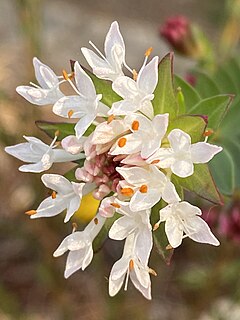
Pimelea ciliata, commonly known as white banjine, is a species of flowering plant in the family Thymelaeaceae. It is a small shrub with white flowers and is endemic to Western Australia.

Pimelea argentea, commonly known as silvery leaved pimelea, is a species of flowering plant in the family Thymelaeaceae and is endemic to the south-west of Western Australia. It is an erect shrub with densely hairy young stems and leaves, the leaves linear to elliptic, and heads of white to yellow or greenish flowers, the male and female flowers on separate plants.
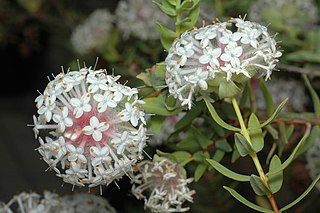
Pimelea avonensis is a species of flowering plant in the family Thymelaeaceae and is endemic to the south-west of Western Australia. It is a shrub with narrowly egg-shaped or elliptic leaves and clusters of white, tube-shaped flowers.
Pimelea brevifolia is a species of flowering plant in the family Thymelaeaceae and is endemic to the south-west of Western Australia. It is an undershrub or shrub with erect, elliptic leaves, and heads of white flowers surrounded by four involucral bracts.
















